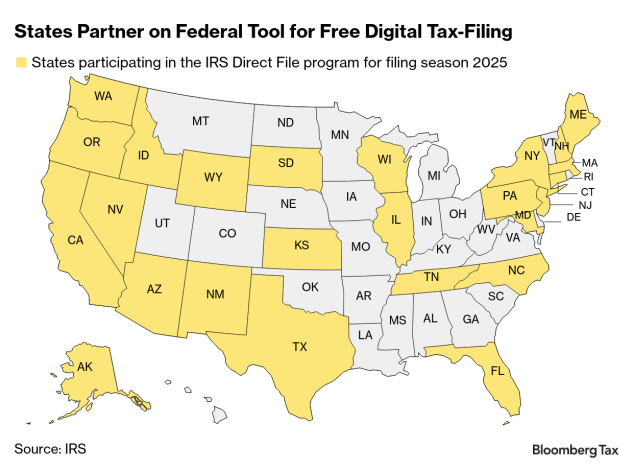- Many eligible taxpayers have yet to use free filing tool
- IRS staff cuts, privacy concerns may impact usage
States that partnered with the IRS to offer a free tax-filing platform are seeing little demand for the program so far this year.
The IRS’s Direct File program, first tested in 2024, became available to more than 30 million taxpayers across 25 states for this tax filing year. Many of those participating states created integrated platforms offering both federal- and state-filing services, while others directed taxpayers to use standalone state-run tax preparation services after filing federal returns.
But few eligible taxpayers have taken advantage of the option ahead of the April 15 deadline to submit returns, according to data collected from several state tax departments. The IRS didn’t respond to requests for comment on Direct File. About 140,000 taxpayers participated in last year’s pilot.
The low participation rate reflects several barriers to wider adoption for the 2025 tax filing season, practitioners and officials said. It remains to be seen whether this year’s demand will impact the program’s future viability—Republicans in Congress have opposed expanding the program launched under former President
Critics could seize on this year’s underwhelming engagement as a reason to end Direct File, but it’s unclear if President
“There just doesn’t seem to be a valid reason to continue a program that has demonstrated it’s not going to be used by taxpayers,” said David Ransom, counsel at the American Coalition for Taxpayer Rights, a group of tax-prep companies that includes
Program Challenges
More than three million New Yorkers were eligible to use the IRS’s Direct File program this year, but only 17,500 filers took advantage of the program through April 11, said Darren Dopp, a spokesperson for New York’s Department of Taxation and Finance. Other states reported similar participation rates.
New Jersey filers submitted more than 6,800 federal and state tax returns as of April 14 through Direct File, which was open to more than 1 million taxpayers. Close to 1.7 million North Carolina filers were eligible to use the free tax filing system, but the state revenue department counted 7,300 state returns as of April 9.
Idaho—the only participating Republican-controlled state that collects state income tax—received 1,540 returns through Direct File as of April 9, out of an estimated 210,000 eligible taxpayers. And in New Mexico, 1,716 took advantage of the free tax filing software as of April 9, out of roughly 300,000 qualifying taxpayers.
State tax departments could see a surge in Direct File use at Tuesday’s deadline and later on for filers who request the October extension. Still, the slow uptake suggests many peculiarities in this year’s tax filing season may have turned taxpayers away from the free filing method, tax policy analysts said.
Privacy concerns over the handling of taxpayer data could lower filing rates across the board, said Adam Ruben, vice president of campaigns and political strategy at the Economic Security Project, an advocacy group that supports Direct File.
The Elon Musk-led Department of Government Efficiency’s efforts to access taxpayer data has prompted lawsuits from attorneys general in 19 states. Undocumented workers may opt not to pay taxes after the IRS agreed to share taxpayer data with US immigration authorities.
“People feel more nervous and hesitant about filing their taxes,” Ruben said.
Many filers may not be aware the program exists in the first place due to deep staff cuts across the IRS, said Vanessa Williamson, senior fellow at the Urban-Brookings Tax Policy Center, a think tank.
“It’s really no surprise that an agency experiencing so much chaos would be unable to properly promote what is a demonstrably effective service,” she said.
Dopp said it’s difficult to convince people to leave a familiar tax-prep service—especially if they’re unsure if Direct File will continue. Those who do, though, report promising results, he said—in New York, 80% of returns were completed in under 15 minutes, with a 96% satisfaction score.
Impact on States
Any future changes to Direct File won’t just impede the ability to submit federal returns for free, but state tax forms too.
While some taxpayers have long been able to submit federal taxes at no cost through the IRS’s Free File program, they often still had to pay to file their state returns. With Direct File, a broader spectrum of taxpayers have been able to file both without cost.
Many states had free filing tools before Direct File, allowing certain taxpayers to submit their state returns, but those systems are getting more activity because the IRS’s Direct File program will refer users to their state option.
Oregon taxpayers submitted 7,100 tax returns last year through the state’s free tax-filing platform, which was available before the state joined IRS’s Direct File, said Robin Maxey, a spokesperson for the Department of Revenue. So far this year, the state tool has received 10,891 state income tax returns, with 3,901 of those coming through Direct File. About 640,000 Oregon taxpayers are eligible to use Direct File this year.
Other states, including New York, used the launch of Direct File to create an integrated platform for filing both state and federal tax returns. Dopp said it’s unclear how the ability to file New York tax returns for free through the agency would be affected if the federal Direct File program ends.
“Everyone files their state and federal taxes at the same time—they need to be coordinated,” Dopp said, adding the ability to continue those capabilities is “another part of the uncertainty moving forward.”
— With assistance from
To contact the reporter on this story:
To contact the editors responsible for this story:
Learn more about Bloomberg Tax or Log In to keep reading:
See Breaking News in Context
From research to software to news, find what you need to stay ahead.
Already a subscriber?
Log in to keep reading or access research tools and resources.

